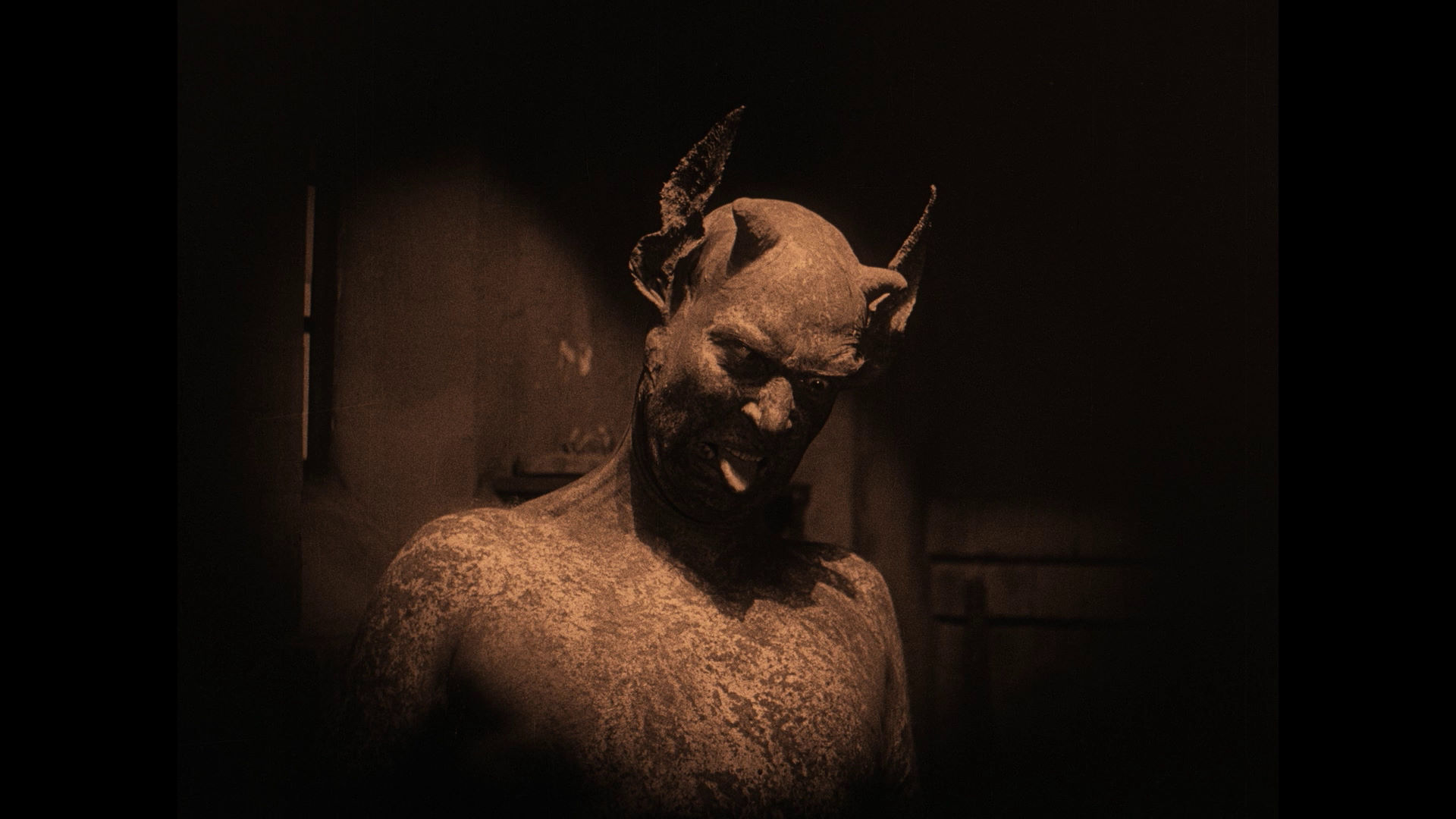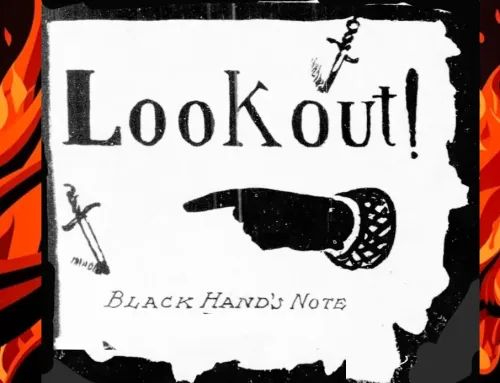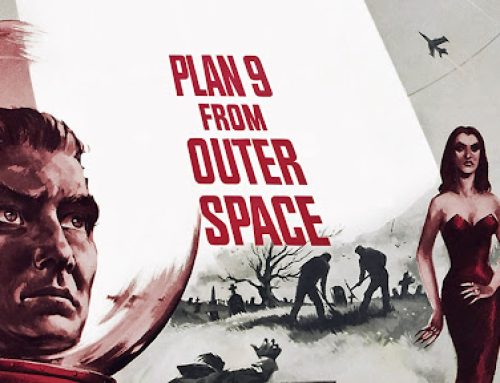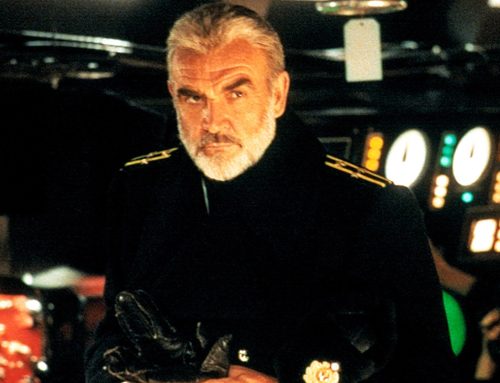11. The Wolf Man (1941) Lon Chaney Jr. follows in his fathers footsteps in his debut as a horror actor. This is something that would desperately hurt his career, forcing him to be typecast in horror films for the rest of his life, but the character of the Wolf Man would seal his place in movie history. The Wolf Man is the story of Lyle Talbot who gets bitten by a werewolf and is now faced with the terror of changing to a wolf on the full moon and feasting on the villagers of a small European town. Chaney pulls all the emotional stops as a good man who is tortured by the curse that has fallen upon him and plays the part with frantic anguish and heaps of emotion. Chaney is also joined by a fantastic cast of co-stars including Claude Raines as his father Sir John Talbot, early scream queen Evelyn Ankers as Talbot’s romantic interest Gwen Conliffe, Maria Ouspenskaya as the mysterious gypsy Malvera and Bela Lugosi as the werewolf who attacks Chaney and turns transfers the curse onto him. The Wolf Man is, by far, the greatest of all the Universal horror films and the scariest of all of the Universal monsters.
12. The Lodger (1944) Laird Cregar plays Mr. Slade, aka Jack the Ripper, in this historically inaccurate, although highly entertaining, interpretation of history’s most famous unsolved mystery. A series of murders in Whitechapel has taken London by storm, and is on the minds and tongues of the citizens of London, including the home of Robert and Ellen Bonting who have just rented out a room to the mysterious Doctor Slade. However, unbeknownst to the Bonting’s, Slade is a misogynist with a twisted hatred for actresses, and has been taking his rage out by slaying washed up dance hall girls under the moniker Jack the Ripper. However, as fate would have it (they always do in the movies, now don’t they) the Bonting’s niece Kitty Langely, played by the ravishing Merle Oberon, is London’s newest stage sensation, and also lives in the house! Meanwhile, in another twist of fate, the police inspector that is investigating the Ripper murders, played by George Saunders, just happens to be courting Kitty Langely! Now, as Slade fights off his fascination with Langely, avoids the police and keeps slaying dance hall girls, the Bonting’s begin to suspect the true identity of their mysterious lodger. Dark and moody, The Lodger is full of incredible performances by all the leads, especially Laird Cregar who is fantastic as the disturbed Doctor Slade. Merle Oberon is also charming and spunky as Kitty Langely, and although not much of a dancer as her character is supposed to be, manages to give two surprisingly appropriate musical numbers in the film. The Lodger was not the first time the story of Jack the Ripper was ever filmed, and definatly not the last, and the film at no point attempts to follow the historical events of the crime at all, most notably changing his victims from prostitutes to dance hall girls, and by changing the names of his victims. However, The Lodger remains to be one of the best filmed and best acted versions of the story, and Cregar is possibly the best Jack the Ripper ever to make it to the silver screen.
13. The Uninvited (1944) One part supernatural thriller, one part romantic comedy. The Uninvited is a delightful and odd, often overlooked supernatural thriller. Ray Milland and Ruth Hussey star as siblings who buy an old haunted house. But when Milland meets and falls in love with a village girl named Stella (played by Gail Russell in her screen debut), the hauntings somehow have a weird connection to her. Now Milland and Hussey, along with a local doctor (played by Alan Napier best known for playing Alfred the butler on the Batman TV series) must unravel the mystery of the old house in order to free Stella from the ghosts that haunt her before they destroy her. Compelling and often scary, this film actually manages to be very lighthearted as well, and has a happy ending, being perfect for someone who doesn’t like horror movies.
14. The Body Snatcher (1945) Based on a story by author Robert Lewis Stevenson, producer Val Lewton’s The Body Snatcher awarded Boris Karloff with not only possibly the best film of his career, but arguably his best role rivaled only by the Frankenstein monster. Set in Edinburgh in the late 1800′s, Karloff plays clever and witty coach man John Gray who moonlights as a grave robber, supplying fresh cadavers for classroom medical examination to esteemed Dr. MacFarlane. However, as cemeteries become more guarded and retrieving bodies become more difficult Gray turns to murder to get the bodies needed, and mind games and blackmail to keep the doctor’s mouth shut. An appealing sub-plot featuring a little crippled girl helps the film until its eerie final featuring a runaway coach, a rainstorm and a corpse that creeps out even the most hardened viewer. “The Body Snatcher” also features Bela Lugosi as the doctor’s servant Joseph in the very final pairing of Karloff and Lugosi, and one of Lugosi’s final truly good roles. An intelligent plot, strong script and possibly the greatest performance ever out of Boris Karloff makes The Body Snatcher one of Hollywood’s earliest “thinking man” horror films.
15. The Spiral Staircase (1945) Despite the fact that this gothic whodunit isn’t technically a horror film, it’s influence on the genre is immense, with elements of countless of future horror films, such as Psycho, Black Christmas and Halloween, being influenced by it. When a serial killer begins to murder women with imperfections and defects, including a crippled and a blind victim, the local constable and the kind Doctor Perry begin to worry about the safety of Helen Capel, a beautiful mute servant for the Warren household, made up of feuding stepbrothers Steven and Albert and the ailing and eccentric Mrs. Warren. When Mrs. Warren talks Doctor Perry into taking Helen out of the house and in his protection on a dark and stormy night, Helen and Dr. Parry agree. However, time is at an essence because strange things are happening at the Warren estate, and the killer is already in the house! Although predictable at times, this great gothic chiller is highlighted by lavish sets, moody lighting and fantastic performances, especially by Dorothy McGuire who does the entire film without uttering hardly a sound. Although mute, McGuire gives the most compelling performance of the film. Fantastic cinematography would be studied and copied by directors for decades to come, and the idea of a mysterious serial killer who is closer then you think would be copied time and time again. More of a thriller or a film noir then a true horror film, The Spiral Staircase is a creepy watch, but belongs in the history of horror for it’s trendsetting plot devices that would be used in horror films to this day.
16. Abbott and Costello Meet Frankenstein (1948) Classic comedy team Bud Abbott and Lou Costello are teamed up with Bela Lugosi, Lon Chaney Jr. and Glenn Strange in what is not only a spoof of their famous horror films, but also a loving tribute. When the beautiful Dr. Sandra Mornay, played by Lenore Aubert, teams up with Count Dracula to revive the Frankenstein Monster, they decide that they must replace his brain with someone far more stupid and controllable so that the monster will do their bidding. Well Dr. Mornay finds the perfect brain to create a docile monster – Lou Costello’s. However only one man knows the truth and wants to save Costello from his grizzly fate, the strange and paranoid Larry Talbot. But Talbot isn’t much help when the moon turns full and he turns into the Wolf Man! Now Abbot and Costello find themselves lurking around misty swamps and dark castles full of secret passages and the silver screen’s most famous monsters. Abbott and Costello Meet Frankenstein is truly a remarkable comedy. Despite the fact that comedy has changed so much through the decades, after sixty years the film holds up due to the fact that the comedy is based on a truly universal concept – being scared. Most of the comedy revolves around buffoon Costello seeing the monsters and freaking out, and straight man Abbott not seeing them and chastising Costello for being a fool. Despite this simple and repetitive concept, Abbott and Costello manage to keep it fresh and funny from scene to scene. Furthermore, with such iconic characters at their disposal, every generation since it’s film release need little to no introduction on the characters or films that they are spoofing making the film timeless. Horror spoofs like Scary Movie will not have this sort of success. Abbott and Costello are dead on with their word play, throw away lines and aggressive behavior towards each other. Furthermore, it is a real treat to see Bela Lugosi once again in the role of Dracula. This film marks the second and final time that he would put on the cape as the famous Count, and it is a return to big budget greatness after a number of years in being reduced to low budget cheapies. Lugosi shines in this film, and plays along masterfully with the stars and is both charming and funny. However not everybody works well with this picture. Lon Chaney Jr. seems uncomfortable in his role, and often looks like a fish out of water. In reality, he was very unhappy with the project and made an unsuccessful suicide attempt the night of its premier! Also, Glenn Strange is underused through the majority of the film, but his fantastic rampage at the finale makes up for it. Abbott and Costello Meet Frankenstein also features a surprise cameo by another classic Universal monster, being played by a fourth horror icon. I wont give away the surprise, but I’ll give you a hint. It’s not Karloff. He would appear in the follow up feature Abbott and Costello Meet the Killer, Boris Karloff. Abbott and Costello Meet Frankenstein is a fun film, and a great way to for Universal say goodbye to the Wolf Man, Dracula and the Frankenstein Monster. Horror fans are given a real gift for the final chance to see these classic monsters being played by men who made the famous.
17. The Creature From the Black Lagoon (1954) The last of the great Universal movie monsters makes his debut in this big budget B film! Simple bare bones plot follows an expedition of scientists who go searching for evidence of a primitive human/fish hybrid from prehistoric days after a fossil of a webbed hand is discovered in the Amazon. Ending up in a remote lagoon where it has been said nobody has ever returned from, the team discovers that they are not alone in the jungle and the legendary Gill Man still swims the waters of the Black Lagoon! Soon an inner battle erupts amongst the group, as two scientists in love with the same woman takes their frustrations out on each other over what to do with the Gill Man. Marine biologist David Reed, played by hunky Richard Carlson, wants to study it, but leader Mark Williams, played by Richard Denning, wants to bring it back for fame and fortune. But before they can do either, they’ll have to capture the Gill Man first, and the two feuding associates aren’t the only ones with their sights set on sexy Kay Lawrence, played by Julie Adams. Seems that the Gill Man has his own agenda for her that involves making sure none of the explorers get out of the Black Lagoon alive! Although this film is low on plot, it makes up for it with high production values. The Creature From the Black Lagoon is really nothing more then a B film, but Universal put a decent budget and the right amount of time into the film to make sure that it looked great! The underwater photography of the men battling the Gill Man, and the Gill Man stalking Julie from underneath during a swim in the lagoon is fantastic. Also, the Gill Man himself is easily one of the coolest looking monsters of the 1950s, securing his entry into the horror hall of fame. Decent performances by the cast, especially gritty captain Lucas, played by Nestor Paiva who gets most of the films best lines, are highlighted by leggy Julie Adams in her white one piece bathing suit. The image of her in that swim suit has been the fantasy of many monster movie fans for decades. Followed by a series of sequels, including an uncredited screen debut for Clint Eastwood in the follow up Revenge of the Creature, The Creature From the Black Lagoon is the last of the great Universal Horror films, and the most legendary of all the 1950s era B films.
18. Gojira (1954) Best known throughout the world as Godzilla, Gojira was the original title of the film that started the Godzilla saga, which would become not only one of the cornerstones of the Japanese film industry, but spawn the most direct sequels then any other monster film in horror history and introduce the world to one of the most beloved, and imitated, movie monsters. However, Gojira has hardly been shown in North America, which instead had to watch the highly edited Godzilla, with additional scenes featuring Raymond Burr, but which cut out most of the films best sequences featuring the analogy of the bombing of Nagasaki and Hiroshima, thus dismantling the entire point of the film. When nuclear testing near the coast of Japan awakens a prehistoric beast, the unstoppable creature goes on a rampage of terror and nothing the army can do can stop Godzilla, as its trek of death and horror reaches Tokyo. A compelling sub-plot involving a navy frogman, the daughter of the paleontologist who first discovers Godzilla and the reluctant scientist that is the only man on earth with the power to stop the monster adds to the drama of the film. However, the real star of Gojira is, of course, the monster himself. Being filmed with limited light, and in black and white and with a decent budget, the monster in Gojira actually looks quite convincing and does not look like a guy in a rubber suite as it would in cheaper colored sequel presented later on. The Japanese really didn’t need CGI for this one and it’s really the most convincing dinosaur effects until Jurassic Park decades later. However, Gojira is more then just a monster movie and doubles as a political curiosity piece. The fresh memories of the destruction of Hiroshima and Nagasaki ten years earlier are still felt in this film, and both the destruction of Tokyo and suffering of the Japanese people after Godzilla’s rampage hark back to that dark time in Japanese history. Japan’s struggle against Godzilla is a straight forward and painful analogy to the nuclear holocaust faced by Japan. Naturally, this analogy was cut out for the American audience, which hinders the film enormously. Gojira is one of the great monster movies in the history of cinema, and one of the best films from Japan, and should be seen. Forget the campy Godzilla films that you watched during Saturday matinees of your youth and watch the original Japanese version of Gojira instead. You’ll be surprised just how much of a masterpiece it is. It will challenge your expectations.
19. Invasion of the Body Snatchers (1956) Forget Aliens because Invasion of the Body Snatchers is far more chilling, making it the scariest sci-fi/horror thrillers of all time. A metaphor for America’s cold war paranoia of the 1960’s, Invasions of the Body Snatchers takes place in a small American California city where Dr. Miles Bennell begins to get reports from his patients that their loved ones are not in fact their loved ones. Further investigation finds that aliens are replacing the townspeople with look-alikes that form out of pods in a nearly invisible alien invasion. The climax has the doctor and his girlfriend as the only two people left that have not been replaced fleeing from the alien aggressors. Invasion of the Body Snatchers has been remade a number of times, however the setting of 1950’s America, and the blatant analogy of communist paranoia, has prevented any remakes from being nearly as effective as the original. Skip all imitations and stick to the original Invasion of the Body Snatchers.
20. Curse of Frankenstein (1957) Hammer Studios first began its legacy of creating some of the horror industries best films with their version of the Frankenstein story in this great Peter Cushing vehicle! Making a deal with Universal Studios that they wouldn’t copy the classic Boris Karloff version of the film, Hammer sought out to make their own, unique tale. As a result, instead of focusing the story on the monster, Hammer chose to make a film about Doctor Victor Frankenstein, and as a result creates a fantastic character study of one of literatures greatest characters. When Baron Frankenstein (played by Cushing) and his partner and former tutor Paul Krempe stumble upon the secret of life, instead of using their discovery for medical advancement as originally planned, Frankenstein becomes obsessed with creating a man. As Frankenstein’s ethics become more and more questionable, Krempe disapproval of his experiments sear their relationship, and soon Frankenstein gives up all contact to the people who care about him in order to see his creation born. Christopher Lee also appears as the Frankenstein monster, but his performance is both short and less endearing then that of Karloff’s monster. However it works for this film because this movie is not about the monster but about the creator. A more dynamic performance by Lee would have stolen this picture from Cushing, and Lee would have his own chance to be dynamic later on. A different kind of Frankenstein film, Curse of Frankenstein sealed Hammer’s success, and is a fantastic first entry in the studio’s legacy.





Leave A Comment